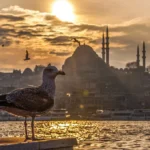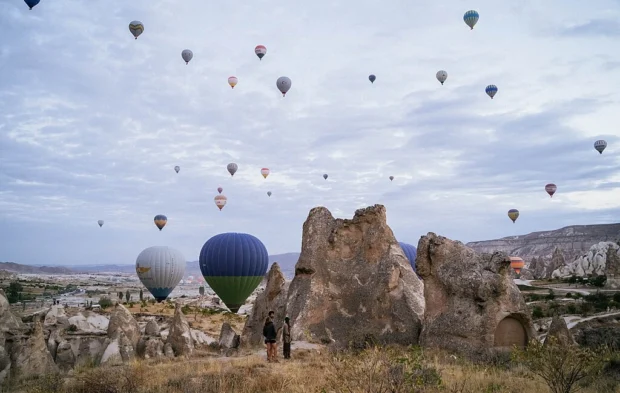Göreme National Park in Cappadocia, Turkey, is a place where nature and history intertwine in a landscape carved by ancient winds and human hands. Known for its fairy chimneys, rock-cut churches, and sprawling underground cities, this UNESCO World Heritage site offers an unforgettable glimpse into Anatolia’s past and vibrant present. Visitors seeking insight into Turkey’s natural beauty, cultural heritage, and traditional crafts will find Göreme a captivating destination. The park’s unique formations and centuries-old frescoes tell tales of early Christian communities and Byzantine artistry, making it a compelling subject for anyone eager to engage with both nature and history.
Table of Contents
If you enjoy Göreme National Park’s wonders, you might appreciate an overview of Cappadocia’s charming villages and local flavors in Cappadocia Attractions and Local Flavors.
Getting to Göreme National Park
Most travelers arrive in Cappadocia via Kayseri Erkilet Airport or Nevşehir Kapadokya Airport. From either airport, you can take a shuttle service or rent a car for the approximately 1-hour drive to Göreme, the town at the heart of the national park. If you come by bus, several direct routes connect Göreme with major cities such as Istanbul, Ankara, and Nevşehir city center. Once in Göreme, the park’s attractions are within walking or short taxi distance. The compact nature of the town encourages leisurely strolls along cobbled streets, where local workshops and cafes invite discovery.
Nearby Accommodation and Local Delights
While Göreme offers a range of charming cave guesthouses and boutique hotels carved into the volcanic rock, many options spread across nearby towns such as Ürgüp and Avanos, each with its own distinct character. Staying in these areas lets visitors experience varied local atmospheres and traditional Turkish hospitality. When it comes to food, sampling the “Testi Kebab” – a meat and vegetable stew cooked in a sealed clay pot – is a must. Local eateries often serve this along with freshly baked flatbreads and hand-crafted pottery for which the region is renowned. Marketplaces brim with textiles, carpets, and ceramics, reflecting centuries of artisanal skill and trade route influences.
Understanding Göreme’s Landscape and Cultural Heritage
Göreme National Park is a magnificent interplay of volcanic geology and human ingenuity. Over millennia, volcanic ash solidified into soft tuff stone, which was hollowed out by early inhabitants to create homes, churches, monasteries, and entire underground cities. The soft rock allowed intricate frescoes to adorn church walls, many of which survive in remarkable condition, offering insights into early Christian iconography and Byzantine theological themes. The fairy chimneys themselves stand as silent witnesses to natural forces shaping human history.
The Park’s Significance Through Time
This region served as a refuge for early Christians escaping Roman persecution, who carved out sanctuaries and secret meeting places within the rock formations. Later, it became a crossroads for Silk Road caravans, infusing the area with cultural exchanges between Anatolia and the wider Near East. Its enduring appeal lies not just in the spectacle of the landscape but in the deep cultural layering that connects past to present. Archaeological conservation efforts continue to preserve this heritage, offering visitors a chance to engage with one of the eastern Mediterranean’s most evocative sites.
After enjoying Göreme’s unique landscapes, some travelers find a visit to Barcelona’s Park Güell offers a refreshing blend of nature and creative architecture.
Visitor Advice for a Fulfilling Visit
The best periods to visit Göreme National Park are spring (April to June) and autumn (September to November). These seasons provide pleasant weather for hiking and outdoor activities without the intense summer heat or winter snows that may limit access to certain trails. Weekdays tend to be quieter than weekends, allowing for a more contemplative experience among the rock churches and valleys. Early mornings offer an especially magical atmosphere, with soft light illuminating the fairy chimneys and fewer tourists around.
- Wear sturdy walking shoes, as the terrain can be uneven and rocky.
- Bring sun protection and water, particularly when exploring open valleys.
- Respect preservation rules by not touching frescoes or climbing on fragile formations.
- Consider hiring a local guide to enrich your understanding with stories from oral traditions and ethnographic insights.
- Book tours and hot air balloon rides in advance, especially in peak seasons, to secure your place.
Organizing Tours and Reservations
Though self-guided exploration is possible, many visitors choose to join guided tours to access hidden spots and receive detailed historical commentary. Popular options include hiking tours through Rose and Red Valleys, visits to the Open Air Museum featuring cave churches, and underground city excursions. Hot air balloon tours at sunrise remain a highlight for panoramic views of the extraordinary terrain. Booking these activities online or through local agencies in Göreme is recommended, as demand is high and numbers are limited to protect the environment and visitor experience.
For comprehensive information and official updates, visitors can consult the website of the Ministry of Culture and Tourism of Turkey, which oversees Göreme National Park and its conservation:
Göreme National Park
Immersing in the Local Cultural Landscape
Beyond the natural and architectural marvels, Göreme invites reflection on the continuity of human life in this unique terrain. Engaging with local crafts such as pottery and carpet weaving reveals the survival of traditional techniques passed along generations. The regional cuisine, markets, and festivals add layers to this cultural tapestry. Walking through Göreme’s streets, one senses the echoes of ancient trade routes and the harmonies of communities that have lived in balance with the rocky landscape.
On a quiet afternoon, I found myself lingering at a ceramics workshop where the potter explained the symbolic patterns inherited from Byzantine and Seljuk designs, connecting the past to present artistic expression. Such encounters enrich the visit, transforming it from a sightseeing trip to a profound cultural mapping of the eastern Mediterranean’s heart.
Final Reflections on Göreme National Park
Visiting Göreme National Park is more than an excursion to stunning rock formations; it is a journey into a cultural landscape shaped by millennia of human creativity, spiritual devotion, and natural forces. The delicate frescoes, ancient pathways, and warm local hospitality all invite reflection on how history, geography, and art converge in this remarkable place. For those seeking to connect with a site where the past breathes through stone and story, Göreme offers a lasting impression of Anatolian heritage and the enduring dialogue between nature and civilization.

Explorer of historical towns, ancient ruins, and traditional markets, combining modern travel with interest in heritage.
- Göreme National Park and hot air ballons by Andrada Boldis on Wikimedia Commons – cc by-sa 4.0
